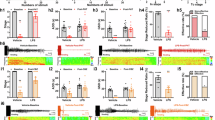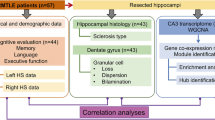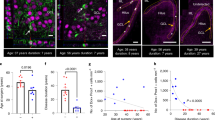Abstract
ABUNDANT clinical and experimental evidence indicates that the hippocampus is involved in temporal lobe epilepsy1,2. Some of the symptoms of excitation associated with the disease may be related to the marked tendency of the hippocampus to produce seizures in response to mechanical, electrical and chemical stimuli3. Focal discharges in the temporal lobe could spread through direct afferents to the nearby entorhinal cortex4. Excitatory projections from entorhinal neurones form the final link in the chain between the sensory neocortex and the hippocampus by making synaptic contact with granule cells of the dentate gyrus. Axons arising from the granule cells synapse, in turn, on the apical dendrites of CA3–4 hippocampal pyramidal cells. These axons comprise the mossy fibre pathway5.
This is a preview of subscription content, access via your institution
Access options
Subscribe to this journal
Receive 51 print issues and online access
$199.00 per year
only $3.90 per issue
Buy this article
- Purchase on SpringerLink
- Instant access to full article PDF
Prices may be subject to local taxes which are calculated during checkout
Similar content being viewed by others
References
Gastaut, H., and Broughton, R., Epileptic Seizures (Thomas, Springfield, 1972).
Jasper, H. H., Ward, A. A., and Pope, A., Basic Mechanisms of Epilepsies (Little, Brown, Boston, 1967).
Green, J. D., Physiol. Rev., 44, 561 (1964).
Van Hoesen, G. W., Pandya, D. N., and Butters, N., Science, N.Y., 175, 1471 (1972).
Andersen, P., Blackstad, T. W., and Lömo, T., Expl. Brain Res., 1, 236 (1966).
Curtis, D. R., and Watkins, J. C., Pharmacol. Rev., 17, 347 (1965).
Krnjevic, K., Nature, 228, 119 (1970).
Crawford, I. L., and Connor, J. D., Fed. Proc., 32, 696 (1973).
Schmidt, E., Methods of Enzymatic Analysis (edit. by Bergmeyer, H.), 752 (Academic, New York, 1965).
Berl, S., Takagaki, G., Clarke, D. D., and Waelsch, H., J. biol. Chem., 237, 2562 (1962).
Adelstein, S. J., and Valee, B. L., J. biol. Chem., 223, 3 (1958).
Maske, H., Naturwissenschaften, 42, 424 (1955).
Haug, F.-M. S̄., Histochemie, 8, 355 (1967).
von Euler, C., in Physiologie de l'Hippocampe (edit. by Passouant, A.), 135 (Editions du CNRS, Paris, 1962).
Crawford, I. L., and Connor, J. D., J. Neurochem., 19, 1451 (1972).
Colburn, R. W., and Maas, J. W., Nature, 208, 37 (1965).
Gramacioli, C. M., Acta Cryst., 21, 600 (1966).
Biscoe, T. J., and Straughan, D. W., J. Physiol., 183, 341 (1966).
Koyama, I., Can. J. physiol Pharmacol., 50, 740 (1972).
Tower, D. B., Neurochemistry of Epilepsy (Thomas, Springfield, 1960).
Van Gelder, N. M., Sherwin, A. L., and Rasmussen, T., Brain Res., 40, 385 (1972).
Gottesfield, Z., and Elazar, Z., Nature, 240, 478 (1972).
Graham, jun., L. T., and Aprison, M. H., Analyt. Biochem., 15, 487 (1966).
Author information
Authors and Affiliations
Rights and permissions
About this article
Cite this article
CRAWFORD, I., CONNOR, J. Localization and Release of Glutamic Acid in Relation to the Hippocampal Mossy Fibre Pathway. Nature 244, 442–443 (1973). https://doi.org/10.1038/244442a0
Received:
Revised:
Issue date:
DOI: https://doi.org/10.1038/244442a0
This article is cited by
-
The opioid peptide dynorphin mediates heterosynaptic depression of hippocampal mossy fibre synapses and modulates long-term potentiation
Nature (1993)
-
In situ measurements of enzyme activities in the brain
The Histochemical Journal (1993)
-
Hypothermia protects somatostatinergic neurons in rat dentate hilus from zinc accumulation and cell death after cerebral ischemia
Molecular and Chemical Neuropathology (1993)
-
Glutamate is the endogenous amino acid selectively released by rat hippocampal mossy fiber synaptosomes concomitantly with prodynorphin-derived peptides
Neurochemical Research (1990)
-
Presynaptic facilitation of glutamate release from isolated hippocampal mossy fiber nerve endings by arachidonic acid
Neurochemical Research (1990)



